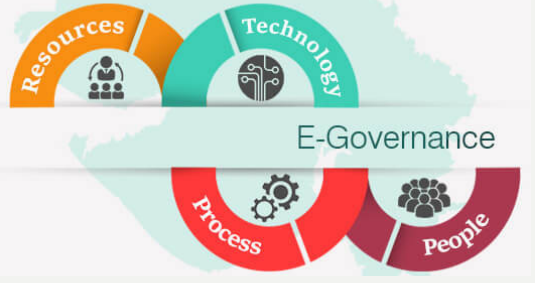${tocify}
What is E-Governance?
It is not an alien fact that covid-19 took over the world like a storm, even faster than the denims or K-Pop! There was no country, society or community which was left untouched by the pandemic and which did not evolve to fit into a digital structure. Our governments were no exception. To overcome the obstacle of not being able to step out of our houses, the screens became our window to interact and carry out our lives as normally as possible. The government offices, structures and processes also took a similar stance and many portals, websites and apps were launched to carry out tasks from Aadhaar verification to vaccination. Some countries like the USA even conducted their elections through online forums and contactless polls. Such a way of going on with government official activities through digital means is e-governance. In formal and descriptive terms, EGovernance is defined as a way to provide and facilitate government services, communication and information through Information and Communication Technology (ICT).
Why do we need of e-Governance? (Application & Advantages)
Now the question arises: why do we need a way to organize the government into a digital structure?
Imagine collecting and maintaining the data of billions of people in the form of physical files. The picture that comes into our mind is of long aisles of dusty and dirty shelves filled with files.
Yes, it might not be so but for even a small government organization, the database is huge and every piece of information is equally vital. Now, if this information is stored in proper software, then it reduces time and effort as well as prevents data redundancy, duplicity of data and saves storage space. Same goes with forms, applications and submissions. The physical copy trend has been going on since long and is very vital but it also poses the same problems. Formulating online forums, platforms, channels and websites to access the required information, get the relevant process started, verify whatever information was provided and then giving the provided result within the span of two weeks automatically reduces half the burden of the officials and reverts the human resource to more useful tasks. It also automatically enters the new data in relevant places and keeps records up to date. In India, online vaccination, online Aadhaar verification, passport application etc. are excellent examples of E-Governance which have worked successfully till now. E-governance, therefore, surely makes the system a bit more efficient and smooth sailing.
Disadvantages of E-Governance
However, it does put doubts in many a head regarding the safety of their private information and their security. Governments are already the target of many hackers and haters with varying interest and the large amount of data makes it even more tempting to access it. Data theft is a serious risk with e-governance and is one of the major concerns, other than that a corrupted official could do as much harm by leaking or selling the information, a trade for which they will be highly paid for and be lavishly compensated. This data could consist of bank details, social security details and much more. It could be exploited by foreign governments or fraudulent firms for their own evil intentions which could pose a threat to the national integrity of a nation. Data loss is also a very big threat that could lead to loss of money, time and effort. Doing it all over again is a task and there would be no one to blame or put the responsibility on.
Conclusion
Therefore, E-Governance is surely a revolution which increases efficiency and transparency of governments, yes there are a few threats but governments are strong institutions which should be able to uphold their security and protect themselves from such threats. It is definitely an amazing and optimal way of governance that nations should adopt to practice better democracy and increase accountability.

